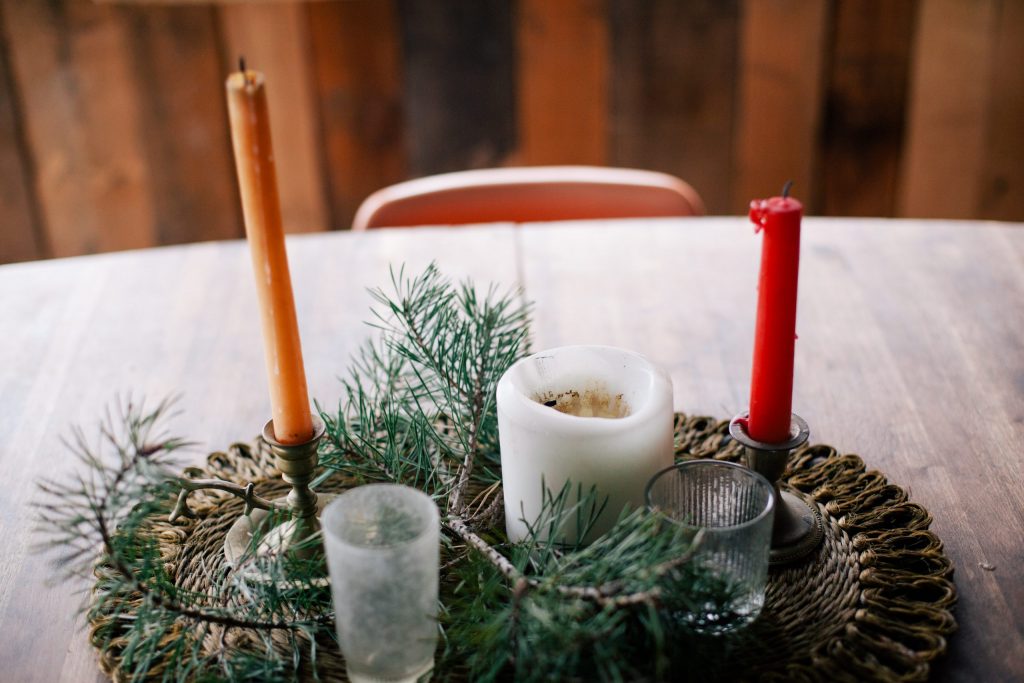by Sarah Robinson

One of the many joys of being a witch is embracing the beauty of every season in the wheel of the year. But I have an extra special place in my heart for winter, a time to draw inwards both physically and mentally.
Seeking warmth and comfort beside hearth fires and perhaps setting out a few extra candles to bring light into the darkest days of the year. As witches, we have never feared the dark, and ahead are just a few ways to celebrate and connect to the season. I have drawn on ideas and inspiration from a variety of cultures, and as always, I encourage respect and gratitude when exploring beliefs and traditions around the world.
Honour the full Moons of Winter
Early Native Americans tribes gave each full moon a name. Many of the names relate to events in the natural world or farming that took place at the time, although names could differ from tribe to tribe. Colonial Americans adopted some of the moon names and applied them to their own calendar system, and they are still often mentioned in relation to farming.
November: Frost Moon
The first of the winter frosts begin to arrive.
December: Cold Moon
For those long, cold and dark nights of Winter.
Alternative names: moon before Yule, long nights moon
January: Wolf Moon
January was a time of hunger for wild animals such as wolves; food was scarce and nights were long.
Tribes would hear wolf packs howling in hunger around this time of the year.
February: Snow Moon
February is the snowiest month in America, hence the name for snow moon.
Alternative names: Hunger moon (hunting is hard in snowy weather, so both man and wolf were going hungry in the early months of the year)
Call on the Celtic Goddesses of Winter
Tales of the Celtic Goddesses hail from Ireland, Scotland and England (as well as parts of Europe). Many of the most powerful Celtic deities are female, from strong, nurturing earth mothers to fierce goddesses of war, every bit as powerful as their male counterparts. Woman and the Feminine held a very high status in Celtic society.
The Cailleach
The Celtic crone goddess, Queen of Winter, sweeps her cloak of winter white over the land. She freezes the ground during winter months, she is the personification of the elemental power of nature. The Cailleach governs the winter months between Samhain (1 November) and Beltane (1 May) -wWhile flame-keeper Brighde rules the summer months between Beltane and Samhain. The Calleach is the creatrix of the land; mountains, hills and valleys - dropping and carving rocks and mountains to serve as her stepping stones. Channel The Cailleach and walk the land, mountains and cliff paths this Winter; take in the stark beauty of nature in the winter months.
Kerridwen, Keeper of the Cauldron
Kerridwen and her cauldron are a symbol of knowledge and transformation. Like the Callieach, she is often depicted as a wise crone woman. I love to channel Kerridwen with simple Kitchen Witchcraft; working in the kitchen is the art of transformation. We take ingredients and transform them into something completely different, feeding ourselves and our families. In this way, we are very much like Kerridwen as we stir our pots and cauldrons. To draw in her powers, you can use some of the herbs and foods connected to her energy. Try earthy bay leaf, nutmeg, sage, apples, pears and pumpkins.
The Winter Sabbats
Samhain
Northern Hemisphere: 31 October/1 November; Southern Hemisphere 30 April/1 May
At Samhain, the darker half of the year commences. Celebrated as a magical time, for many pagans, it is the beginning of the new year. With the commencement of this dark phase comes the invitation to rest and reflect on the past year, and to dream of new beginnings. Seeds now hidden in the earth will germinate in Spring.
Samhain is the last of the harvest festivals, and a fire festival. The harvest of nuts and berries has been gathered in, all is complete, it is the end of this yearly cycle of birth and growth.
Of the various ideas about the root of this word, my favourite origin story is from the Celtic word Samani that means Assembly/coming together. It also translates as 'summer's end.'
Winter Solstice or Yule
Northern Hemisphere: 21/22 December; Southern Hemisphere: 21/22 June
The shortest day: from this day forth, the days grow longer.
Derived from Middle English yol and Old English geōl; for this pagan midwinter festival. This Sabbat signals the gradual returning to light.
Imbolc
Northern Hemisphere: ½ February; Southern Hemisphere: 31 July/1 August
Imbolc is a Celtic word, meaning 'in the belly or womb', and the festival is dedicated to fertility.
Imbolc is the first stirrings of Spring, the first sparks of new life; snowdrops and lambs may be appearing.
Ideas, themes and inspiration
The time in between each festival also has its own energy and significance, which can be honoured in ritual, spellwork and yoga practice...
Winter Solstice Ideas
Element: Earth
Altar Items: Berries and pine needles, mistletoe, bells
Yoga for the winter season: Find deep rest as the earth rests, with Yoga Nidra and restorative practices.
Meditation themes: deep darkness, quiet and sleep
Journal questions: Do I allow myself to truly rest? Am I listening to my heart?
Surrendering (Samhain to Winter Solstice)
Surrender with your inner yogi: Explore ways to release safely through movement. Practice letting go and embrace the art of surrender and rest.
Surrender with your inner witch: A time for cutting ties and finding ways to release all that no longer serves you. Take some time to face your shadows and heal.
Surrender with your inner creatrix: As we are slowing things down, coming back to ground, you may wish to explore your stories and ancestral heritage.
Resting (Yule to Imbolc)
Rest with your inner yogi: This is a time for silence and stillness; think yin yoga and meditation.
Rest with your inner witch: Enjoy this chance to rest and explore your dream time; record your dreams or journey as the Hedge Witch through meditation and visualisation.
Rest with your inner creatrix: Create light in these darkest months; make candles, bright altars and bring out your own sources of light and joy to the darker evenings.
Finding the rhythms and cycles in the year can help you find connection and create your rituals to celebrate and honour these moments. Your daily rituals do not need to be complicated or even planned - but take time to enjoy the little moments of wonder as they arise. Every new day can mean something to you, a chance to let go of the whispers of the previous day. Your days do not always have to be perfect, but let them mean something to you; something learnt, something released, something honoured. Ceremony and ritual can be a time to carry yourself and your soul in a sacred way. But it's not the only time to do that. Rituals remind us that we are sacred, and to carry yourself in a sacred way every single day.
Blessed Be.
 About the author
About the author
Sarah Robinson is a yoga and meditation teacher in Bath, UK. She is also a Goddess Guide, Author and Earth Witch. Her background is in science; she holds an MSc Psychology and Neuroscience and has studied at Bath, Exeter and Harvard University. Through work with yoga, meditation and The Goddess temples of Glastonbury and Bristol, She had found a love of combining science, spirit and seasonal sparkle. Sarah’s book Yoga for Witches inspired some of the goddesses included in this article and will be published in early 2020 by Womancraft Publishing, available to buy via Amazon, Waterstones and all good bookstores.

 About the author
About the author